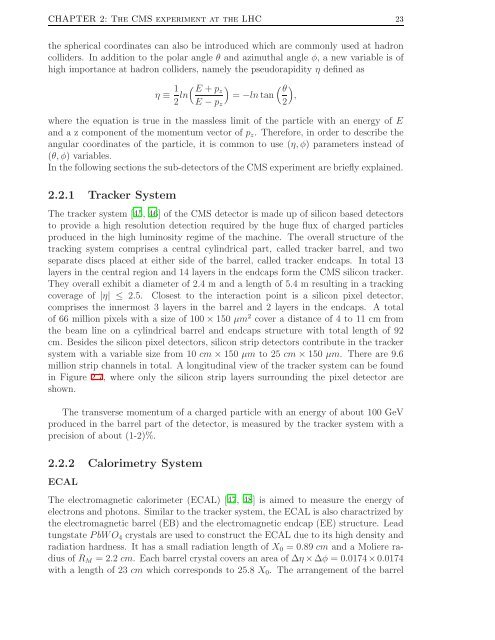Measurement of the Jet Energy Scale in the CMS experiment ... - IIHE
Measurement of the Jet Energy Scale in the CMS experiment ... - IIHE
Measurement of the Jet Energy Scale in the CMS experiment ... - IIHE
Create successful ePaper yourself
Turn your PDF publications into a flip-book with our unique Google optimized e-Paper software.
CHAPTER 2: The <strong>CMS</strong> <strong>experiment</strong> at <strong>the</strong> LHC 23<strong>the</strong> spherical coord<strong>in</strong>ates can also be <strong>in</strong>troduced which are commonly used at hadroncolliders. In addition to <strong>the</strong> polar angle θ and azimuthal angle φ, a new variable is <strong>of</strong>high importance at hadron colliders, namely <strong>the</strong> pseudorapidity η def<strong>in</strong>ed asη ≡ 1 ( E +2 ln pz) ( θ= −ln tan ,E − p z 2)where <strong>the</strong> equation is true <strong>in</strong> <strong>the</strong> massless limit <strong>of</strong> <strong>the</strong> particle with an energy <strong>of</strong> Eand a z component <strong>of</strong> <strong>the</strong> momentum vector <strong>of</strong> p z . Therefore, <strong>in</strong> order to describe <strong>the</strong>angular coord<strong>in</strong>ates <strong>of</strong> <strong>the</strong> particle, it is common to use (η, φ) parameters <strong>in</strong>stead <strong>of</strong>(θ, φ) variables.In <strong>the</strong> follow<strong>in</strong>g sections <strong>the</strong> sub-detectors <strong>of</strong> <strong>the</strong> <strong>CMS</strong> <strong>experiment</strong> are briefly expla<strong>in</strong>ed.2.2.1 Tracker SystemThe tracker system [45, 46] <strong>of</strong> <strong>the</strong> <strong>CMS</strong> detector is made up <strong>of</strong> silicon based detectorsto provide a high resolution detection required by <strong>the</strong> huge flux <strong>of</strong> charged particlesproduced <strong>in</strong> <strong>the</strong> high lum<strong>in</strong>osity regime <strong>of</strong> <strong>the</strong> mach<strong>in</strong>e. The overall structure <strong>of</strong> <strong>the</strong>track<strong>in</strong>g system comprises a central cyl<strong>in</strong>drical part, called tracker barrel, and twoseparate discs placed at ei<strong>the</strong>r side <strong>of</strong> <strong>the</strong> barrel, called tracker endcaps. In total 13layers <strong>in</strong> <strong>the</strong> central region and 14 layers <strong>in</strong> <strong>the</strong> endcaps form <strong>the</strong> <strong>CMS</strong> silicon tracker.They overall exhibit a diameter <strong>of</strong> 2.4 m and a length <strong>of</strong> 5.4 m result<strong>in</strong>g <strong>in</strong> a track<strong>in</strong>gcoverage <strong>of</strong> |η| ≤ 2.5. Closest to <strong>the</strong> <strong>in</strong>teraction po<strong>in</strong>t is a silicon pixel detector,comprises <strong>the</strong> <strong>in</strong>nermost 3 layers <strong>in</strong> <strong>the</strong> barrel and 2 layers <strong>in</strong> <strong>the</strong> endcaps. A total<strong>of</strong> 66 million pixels with a size <strong>of</strong> 100 × 150 µm 2 cover a distance <strong>of</strong> 4 to 11 cm from<strong>the</strong> beam l<strong>in</strong>e on a cyl<strong>in</strong>drical barrel and endcaps structure with total length <strong>of</strong> 92cm. Besides <strong>the</strong> silicon pixel detectors, silicon strip detectors contribute <strong>in</strong> <strong>the</strong> trackersystem with a variable size from 10 cm × 150 µm to 25 cm × 150 µm. There are 9.6million strip channels <strong>in</strong> total. A longitud<strong>in</strong>al view <strong>of</strong> <strong>the</strong> tracker system can be found<strong>in</strong> Figure 2.7, where only <strong>the</strong> silicon strip layers surround<strong>in</strong>g <strong>the</strong> pixel detector areshown.The transverse momentum <strong>of</strong> a charged particle with an energy <strong>of</strong> about 100 GeVproduced <strong>in</strong> <strong>the</strong> barrel part <strong>of</strong> <strong>the</strong> detector, is measured by <strong>the</strong> tracker system with aprecision <strong>of</strong> about (1-2)%.2.2.2 Calorimetry SystemECALThe electromagnetic calorimeter (ECAL) [47, 48] is aimed to measure <strong>the</strong> energy <strong>of</strong>electrons and photons. Similar to <strong>the</strong> tracker system, <strong>the</strong> ECAL is also charactrized by<strong>the</strong> electromagnetic barrel (EB) and <strong>the</strong> electromagnetic endcap (EE) structure. Leadtungstate PbWO 4 crystals are used to construct <strong>the</strong> ECAL due to its high density andradiation hardness. It has a small radiation length <strong>of</strong> X 0 = 0.89 cm and a Moliere radius<strong>of</strong> R M = 2.2 cm. Each barrel crystal covers an area <strong>of</strong> ∆η ×∆φ = 0.0174 ×0.0174with a length <strong>of</strong> 23 cm which corresponds to 25.8 X 0 . The arrangement <strong>of</strong> <strong>the</strong> barrel
















